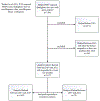Association of firefighting exposures with lung function using a novel job exposure matrix (JEM)
- PMID: 38233128
- PMCID: PMC11267455
- DOI: 10.1136/oemed-2023-109155
Association of firefighting exposures with lung function using a novel job exposure matrix (JEM)
Abstract
Objectives: Characterisation of firefighters' exposures to dangerous chemicals in smoke from non-wildfire incidents, directly through personal monitoring and indirectly from work-related records, is scarce. The aim of this study was to evaluate the association between smoke particle exposures (P) and pulmonary function.
Methods: The study period spanned from January 2010 through September 2021. Routine firefighting P were estimated using fire incident characteristics, response data and emission factors from a novel job exposure matrix. Linear mixed effects modelling was employed to estimate changes in pulmonary function as measured by forced expiratory volume in one second (FEV1). Models controlled for age, race/ethnicity, height, smoking and weight.
Results: Every 1000 kg P was associated with 13 mL lower FEV1 (β=-13.34; 95% CI=-13.98 to -12.70) over the entire 12-year follow-up period. When analysing exposures within 3 months before PFT measurements, 1000 kg P was associated with 27 mL lower FEV1 (β=-26.87; 95% CI=-34.54 to -19.20). When evaluating P estimated within 3 months of a pulmonary function test (PFT), stronger associations were observed among those most highly exposed to the World Trade Center (WTC) disaster (β=-12.90; 95% CI=-22.70 to -2.89); the association of cumulative exposures was similar for both highly and less highly exposed individuals.
Discussion: Smoke particle exposures were observed to have modest short-term and long-term associations with pulmonary function, particularly in those who, previously, had high levels of WTC exposure. Future work examining the association between P and pulmonary function among non-WTC exposed firefighters will be essential for disentangling the effects of ageing, routine firefighting and WTC exposures.
Keywords: epidemiology; occupational health; respiratory function tests.
© Author(s) (or their employer(s)) 2024. No commercial re-use. See rights and permissions. Published by BMJ.
Conflict of interest statement
Competing interests: None declared.
Figures


Similar articles
-
Blood Leukocyte Concentrations, FEV1 Decline, and Airflow Limitation. A 15-Year Longitudinal Study of World Trade Center-exposed Firefighters.Ann Am Thorac Soc. 2018 Feb;15(2):173-183. doi: 10.1513/AnnalsATS.201703-276OC. Ann Am Thorac Soc. 2018. PMID: 29099614 Free PMC article.
-
Lung Function Trajectories in World Trade Center-Exposed New York City Firefighters Over 13 Years: The Roles of Smoking and Smoking Cessation.Chest. 2016 Jun;149(6):1419-27. doi: 10.1016/j.chest.2015.10.067. Epub 2016 Jan 13. Chest. 2016. PMID: 26836912 Free PMC article.
-
Comparing self-reported obstructive airway disease in firefighters with and without World Trade Center exposure.Am J Ind Med. 2023 Mar;66(3):243-251. doi: 10.1002/ajim.23455. Epub 2023 Jan 4. Am J Ind Med. 2023. PMID: 36597815
-
The Effect of Fire Smoke Exposure on Firefighters' Lung Function: A Meta-Analysis.Int J Environ Res Public Health. 2022 Dec 14;19(24):16799. doi: 10.3390/ijerph192416799. Int J Environ Res Public Health. 2022. PMID: 36554677 Free PMC article. Review.
-
The long-term rate of change in lung function in urban professional firefighters: a systematic review.BMC Pulm Med. 2018 Sep 6;18(1):149. doi: 10.1186/s12890-018-0711-8. BMC Pulm Med. 2018. PMID: 30189854 Free PMC article.
References
-
- Technical Committee on Fire Service Occupational Safety and Health. NFPA 1582, Standard on Comprehensive Occupational Medical Program for Fire Departments. Quincy, USA: National Fire Protection Association; 2018. 11–12..
-
- Sherman CB, et al., Firefighting acutely increases airway responsiveness. Am Rev Respir Dis, 1989. 140(1): p. 185–90. - PubMed
MeSH terms
Substances
LinkOut - more resources
Full Text Sources
Medical
